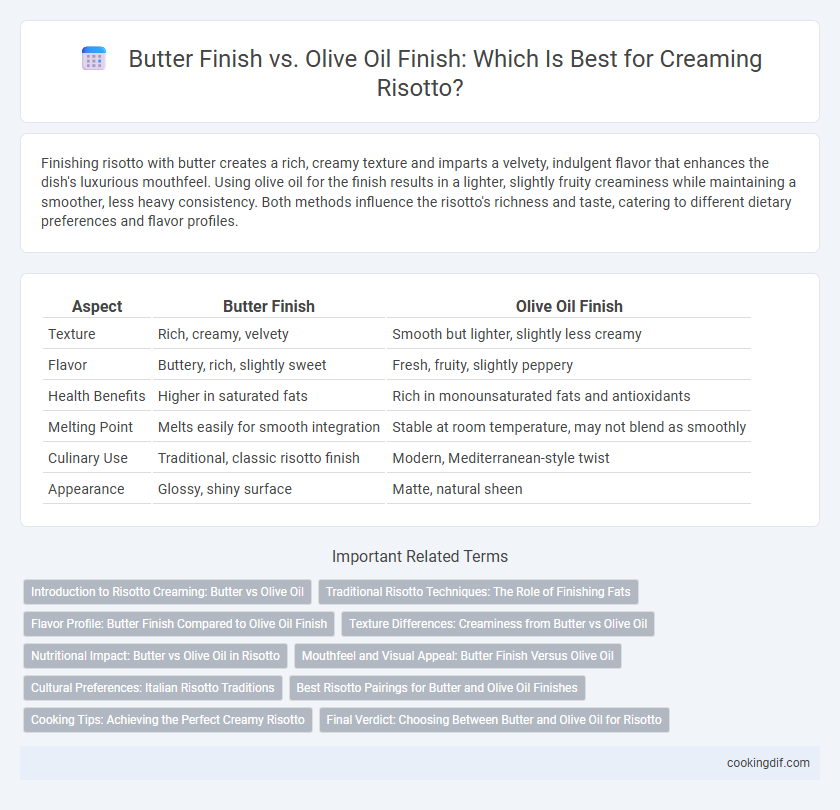Finishing risotto with butter creates a rich, creamy texture and imparts a velvety, indulgent flavor that enhances the dish's luxurious mouthfeel. Using olive oil for the finish results in a lighter, slightly fruity creaminess while maintaining a smoother, less heavy consistency. Both methods influence the risotto's richness and taste, catering to different dietary preferences and flavor profiles.
Table of Comparison
| Aspect | Butter Finish | Olive Oil Finish |
|---|---|---|
| Texture | Rich, creamy, velvety | Smooth but lighter, slightly less creamy |
| Flavor | Buttery, rich, slightly sweet | Fresh, fruity, slightly peppery |
| Health Benefits | Higher in saturated fats | Rich in monounsaturated fats and antioxidants |
| Melting Point | Melts easily for smooth integration | Stable at room temperature, may not blend as smoothly |
| Culinary Use | Traditional, classic risotto finish | Modern, Mediterranean-style twist |
| Appearance | Glossy, shiny surface | Matte, natural sheen |
Introduction to Risotto Creaming: Butter vs Olive Oil
Risotto creaming relies heavily on the choice between butter and olive oil, each imparting distinct textures and flavors. Butter enhances richness and a velvety smooth finish due to its milk fat content, while olive oil offers a lighter, fruitier profile with added antioxidant benefits. Understanding this key difference allows chefs to tailor risotto to preferred taste and mouthfeel profiles.
Traditional Risotto Techniques: The Role of Finishing Fats
Traditional risotto techniques emphasize the role of finishing fats in achieving a creamy texture, with butter finish delivering a rich, velvety mouthfeel that enhances the dish's depth and smoothness. Olive oil finish, often preferred in Mediterranean variations, contributes a lighter, fruitier flavor while maintaining creaminess without overpowering the rice's natural taste. The choice between butter and olive oil impact both the texture and aromatic profile, making finishing fats essential to authentic risotto preparation.
Flavor Profile: Butter Finish Compared to Olive Oil Finish
A butter finish in risotto imparts a rich, creamy texture with a slightly nutty and sweet flavor that enhances the dish's overall indulgence. Olive oil finish offers a lighter, fruitier taste with subtle peppery and grassy notes, adding freshness without overwhelming the rice. The choice between butter and olive oil directly influences the risotto's mouthfeel and depth of flavor, balancing richness versus brightness.
Texture Differences: Creaminess from Butter vs Olive Oil
Butter finish in risotto creates a rich, velvety texture with enhanced creaminess due to its saturated fats, which bind seamlessly with the starches. Olive oil finish results in a lighter, silkier mouthfeel, offering smoothness without the heavy richness, highlighting the natural grain of the rice. The choice between butter and olive oil directly impacts the final risotto's mouthfeel, balancing indulgence and subtlety in creaminess.
Nutritional Impact: Butter vs Olive Oil in Risotto
Butter contributes saturated fats and fat-soluble vitamins like A and E, enhancing the richness and creaminess of risotto but increasing cholesterol levels. Olive oil provides monounsaturated fats and antioxidants such as polyphenols, which support heart health and reduce inflammation while offering a lighter texture. Choosing olive oil over butter lowers saturated fat intake, promoting cardiovascular benefits without compromising the risotto's creamy mouthfeel.
Mouthfeel and Visual Appeal: Butter Finish Versus Olive Oil
Butter finish in risotto enhances mouthfeel by creating a rich, velvety texture and adds a glossy shine, elevating the dish's visual appeal. Olive oil finish offers a lighter, silkier consistency with a subtle sheen that emphasizes freshness and a vibrant look. Choosing butter provides creaminess and a luxurious appearance, while olive oil delivers a refined, slightly translucent finish ideal for a healthier, elegant presentation.
Cultural Preferences: Italian Risotto Traditions
Italian risotto traditions emphasize the use of butter for finishing, enhancing the dish's creamy texture and rich flavor that reflects Northern Italy's culinary heritage. Olive oil, more prevalent in Southern Italy, imparts a lighter, fruitier finish aligning with Mediterranean diet principles. The choice between butter and olive oil as a finishing touch highlights regional cultural preferences and contributes to the distinct characteristics of risotto across Italy.
Best Risotto Pairings for Butter and Olive Oil Finishes
Butter finish enhances risotto with a rich, creamy texture that pairs perfectly with mushroom, truffle, and Parmesan-based dishes, elevating earthy and umami flavors. Olive oil finish offers a lighter, fruitier profile ideal for seafood risottos or those featuring fresh herbs, asparagus, and lemon, complementing delicate and vibrant ingredients. Choosing between butter and olive oil hinges on balancing richness with freshness to create a harmonious flavor profile tailored to the risotto's core components.
Cooking Tips: Achieving the Perfect Creamy Risotto
For the creamiest risotto, finishing with butter creates a rich, velvety texture by emulsifying the starch released during cooking, enhancing the mouthfeel and flavor depth. Olive oil offers a lighter, fruitier finish that preserves the dish's brightness while providing smoothness, ideal for those seeking a Mediterranean twist. Choosing between butter or olive oil depends on the desired creaminess level and flavor profile, allowing customization of the risotto's final consistency and taste.
Final Verdict: Choosing Between Butter and Olive Oil for Risotto
Butter finish delivers a rich, creamy texture and classic flavor that enhances the traditional risotto experience. Olive oil finish offers a lighter, fruity aroma and a healthier fat profile, perfect for those seeking a Mediterranean twist. Choosing between butter and olive oil depends on desired richness, flavor intensity, and dietary preferences for the final risotto creaminess.
Butter finish vs Olive oil finish for creaming Infographic

 cookingdif.com
cookingdif.com